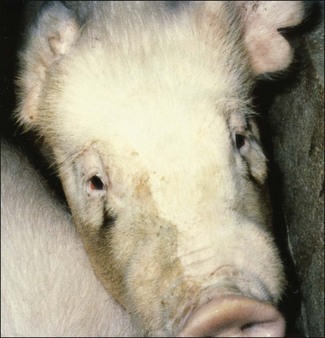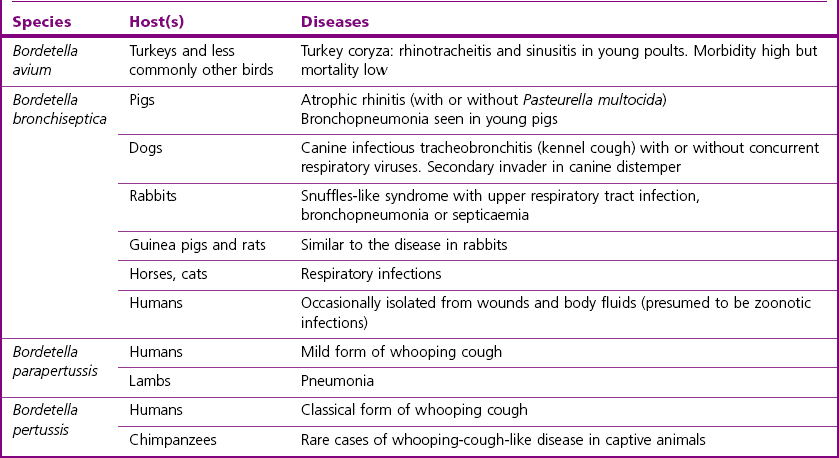Chapter 28 The bordetellae are associated with contagious respiratory diseases with high morbidities and low mortalities. Typical clinical signs include coughing with or without dyspnea, ocular or nasal discharge and weight loss. The severity of the disease increases with concomitant infection with other pathogenic respiratory agents. Table 28.1 summarizes the main diseases and hosts of Bordetella species. Bordetella bronchiseptica is the aetiological agent of infectious tracheobronchitis (kennel cough) in dogs and atrophic rhinitis in pigs. Respiratory infections associated with B. bronchiseptica have also been described in rabbits, cats, horses, rats, guinea pigs and less commonly in wildlife. Zoonotic diseases such as wound infections, bacteraemia and respiratory infections caused by B. bronchiseptica have been reported in the human literature but seem to be uncommon. Bordetella avium is the aetiological agent of turkey coryza or bordetellosis, a respiratory disease responsible for substantial economic losses in the poultry industry, especially in turkey production. This bacterium can also infect various species of fowl and songbirds (Raffel et al. 2002). Boredetella hinzii is generally regarded as non-pathogenic but some strains may be capable of causing disease in turkeys (Register & Kunkle 2009). Bordetella parapertussis is the cause of a nonprogressive form of pneumonia in lambs and a mild form of whooping cough in humans. Ovine and human strains of B. parapertussis are distinct with different host specificities. Bordetella species virulence factors are summarized in Table 28.2. Virulence factors such as fimbriae (FIM), filamentous haemagglutinin (FHA), pertactin (PTN) and products of the type III secretion system promote adherence and colonization in Bordetella species. Virulence factors such as dermonecrotic toxin (DNT), osteotoxin, adenylate cyclase toxin (ACT), tracheal cytotoxin (TCT), pertussis toxin (PTX), type III secretion proteins and lipopolysaccharide (LPS) alter host tissues and promote lesion formation. Mattoo et al. (2001) reviewed the mechanisms of Bordetella pathogenesis. Table 28.2 Main virulence factors of pathogenic Bordetella species in veterinary medicine Virulent strains of Bordetella species attach firmly to ciliated respiratory epithelium via attachment factors (FHA, FIM or PTN) and this is followed by rapid proliferation, ciliary paralysis and an inflammatory response. Bordetella species also have LPS which likely plays a role in colonization of the respiratory tract (Spears et al. 2000). Certain species of Bordetella produce an extracellular enzyme, adenylate cyclase haemolysin (ACT), which is a member of the RTX (Repeat in Toxins) family and has antiphagocytic activity. Dermonecrotic toxin (DNT) is a thermolabile intracellular polypeptide primarily responsible for nasal turbinate atrophy via alteration of osteoblast differentiation in B. bronchiseptica infections of pigs. It also produces necrotic lesions if injected intradermally. The effect on the turbinate bones is most serious in young pigs under three weeks of age when osteogenesis is most active. Atrophic rhinitis in pigs is transient and self-limiting when caused by B. bronchiseptica alone but the bacterium aids the establishment of the piliated and toxigenic strains of Pasteurella multocida and the combined infection causes more serious and permanent lesions (Fig. 28.1). Bordetella avium produces an osteotoxin which also alters osteoblast functions but without any dermonecrotic activity. Figure 28.1 Pig with early signs of atrophic rhinitis. Note the lacrimation and the shortened, deeply wrinkled snout. Bordetella species infections depress the respiratory clearance mechanisms facilitating invasion by other organisms. Both B. bronchiseptica and B. parapertussis have a type III secretion system (TTSS) which contributes to bacterial survival in the lower respiratory tract of the host (Pilione & Harvill 2006). The type III secretion products seem to be involved in cytotoxicity, apoptosis and inactivation of NF-κB (transcription factor) of eukaryotic cells. It is thought that persistent colonization by B. bronchiseptica may rely on the ability of the bacteria to differentially modulate both macrophage and dendritic cell functions leading to a modified adaptive immune response and subsequent bacterial colonization (Siciliano et al. 2006). Since bordetellae are small Gram-negative coccobacilli, direct Gram-stained smears from specimens are not usually very helpful. A fluorescent antibody technique could be useful for B. bronchiseptica and B. avium. An indirect fluorescent antibody staining technique using monoclonal antibody has been developed to detect B. avium in tracheal sections of turkeys (Saif & Barnes 2003).
Bordetella species
Pathogenicity and Pathogenesis
Genes
Virulence determinants
Functions
cyaABCDE operon
Adenylate cyclase-haemolysin (ACT)
Inhibits phagocytic cell functions
dnt gene
Dermonecrotic toxin (DNT)
Inhibits osteoblast differentiation and produces skin lesions
fimABCD (in FHA operon)
Fimbriae (FIM)
Attachment and colonization in the respiratory tract
fhaB, fhaC (in FHA operon)
Filamentous haemagglutinin (FHA)
FHA is a large (>200 kDa), rod-shaped protein that is both surface-associated and secreted. FHA mediates bacterial adherence to epithelial cells and macrophages in vitro and is required for tracheal colonization in vivo
locus wlb
LPS
Colonization of the respiratory tract, endotoxin activities
metC gene
Osteotoxin
A beta-cystathionase that inhibits osteoblast differentiation
ptx and ptl genes
Pertussis toxin (PTX)
An A-B bacterial toxin with ADP-ribosylating activity which disrupts different eukaryotic cellular functions, secreted only by B. pertussis
prn gene
Pertactin (PTN)
An outer membrane protein adhesin (autotransporter family) involved in eukaryotic cell binding (via a RGD sequence, proline- and leucine-rich repeats)
NA
Tracheal cytotoxin (TCT)
A secreted muramyl dipeptide which stimulates Il-1 production that results in nitric oxide accumulation which causes damage to ciliated tracheal epithelial cells
bscN locus
Type III secretion system (TTSS)
Products of this secretion system are required for the induction of necrosis in infected mammalian cells
bvgAS locus
Sensory transduction system
Locus that encodes a transacting transcriptional regulator and a membrane-spanning sensor protein triggered by environmental signals

Laboratory Diagnosis
Direct microscopy examination
![]()
Stay updated, free articles. Join our Telegram channel

Full access? Get Clinical Tree


Bordetella species
Only gold members can continue reading. Log In or Register to continue

